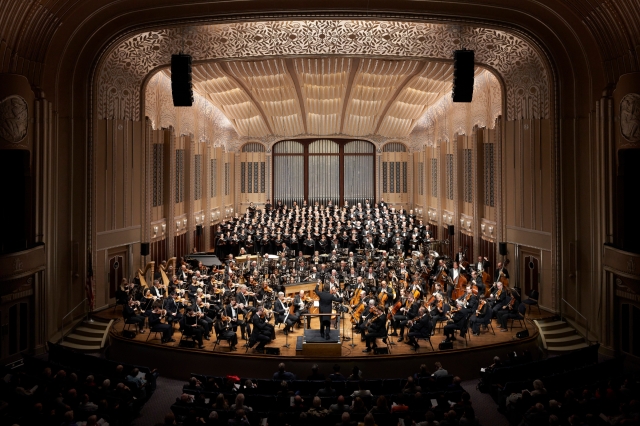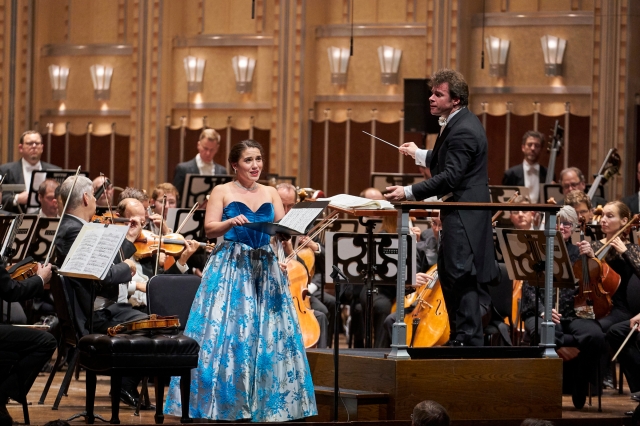Cleveland Orchestra
Jakub Hrůša, conductor
Joélle Harvey, soprano
Cleveland Orchestra Chorus
Lisa Wong, director
Cleveland Orchestra Children’s Chorus
Ann Usher, director
Cleveland Orchestra Youth Chorus
Daniel Singer, director
Severance Hall
Cleveland, OH
November 14, 2019
Adams: On the Transmigration of Souls
Mahler: Symphony No. 4 in G major
Following up on last week’s juxtaposition of Shostakovich and Beethoven, Jakub Hrůša offered a second week of incisive contrasts in Adams and Mahler. Both works were concerned in some fashion with the end of life, though of vastly different orientations. Written as a tombeau for the victims of 9/11, Adams’ On the Transmigration of Souls received its belated Cleveland premiere this week. Conceived almost immediately in the wake of the events memorialized, the work was first performed in New York in September 2002, and earned Adams the Pulitzer Prize for Music the following year.

In addition to large orchestra, chorus, and children’s chorus, the work makes extensive use of pre-recorded electronica, with an elaborate array of speakers wrapping the hall in surround sound. Ambient sounds of the city opened the piece, initially sounding as business as usual, but quickly giving way to sirens and boy’s repeated incantation of “missing.” The choir entered, ethereal and wordless, and strident trumpet solo was heard from an offstage Michael Sachs. It’s a daunting task to adequately capture the emotions of this subject matter in music, and to that end, Adams took pains to eschew any conventional notions of a requiem, instead producing a work with almost no narrative structure, allowing for a multitude of individual responses to its entrancing and mournful solemnity.
Particularly poignant were the recordings of brief tributes to certain victims – one who was described as having “a voice like an angel”: and such a voice we were to hear in the subsequent Mahler. About two-thirds of the way in came a caustic climax, and one could viscerally feel the weight of the events of that day. I would suggest another parallel to Mahler in that it follows a similar arc to the first movement of the Tenth Symphony, spanning roughly the same length, and of autumnal feeling until the shattering crest at about the same point. The music waned, especially doleful as names were read, and matters faded once again into the fabric of the cityscape.
Mahler’s Fourth Symphony has been called the most Viennese of his symphonies, following a more traditional four movement structure and of modest proportions in length and orchestration (by Mahler’s standards, at least). It’s a piece thus particularly well-suited to this orchestra, noted for their classical precision and balance as well as a strong Mahler tradition – and documented in a noted recording of this symphony with Pierre Boulez. The sleigh bells that opened made for a fantastical, almost fairy-tale like atmosphere, countered by graceful strings. The apparent naïveté ran only surface-deep, however, with Hrůša probing beyond its appealing veneer. The winds were in fine form, especially principal flute Joshua Smith, bright and bucolic, and the trumpets hinted at what would become the iconic opening of the Fifth. The more impassioned sections could have benefited from greater clarity, but there was a wonderful moment of serenity before the movement’s boisterous end.
Announced by the horns, the second movement was rooted in the ländler, but as through a distorted lens. Concertmaster Peter Otto coarsely played a detuned violin, emulating a folksy fiddle, and Daniel McKelway’s contributions on the clarinet were shrill yet stylish. The ensuing Ruhevoll opened in a divine simplicity, the strings of the orchestra playing with the intimacy of a quartet. In his pre-concert lecture, Bryan Gilliam keenly noted that Mahler created a nostalgia for a world that never was. The brass were particularly warm in the climactic opening of heaven’s gates, with the strings reaching higher and higher, grounded by the angelic harp. A silky clarinet marked the finale, introducing soprano Joélle Harvey, who previously sang Mahler with this orchestra in last season’s performance of the Second. Her limpid and fluid voice offered the Wunderhorn setting much character, closing each stanza with a profundity that gave weight and authenticity to this child’s depiction of heaven.

